Ornamental Carving on Boston Furniture of the Chippendale Style
AT least three major furniture carvers, each with his own particular style of carving, worked in Boston between the years 1755 and 1785. One style of carving, seen on a chest-on-chest signed by John Cogswell, is notable for its three-dimensionality and the wide shallow grooves articulating the surface of the leaves (fig. 139). Another style, distinguished by two-dimensionality and the thin, narrow grooves used to indicate leaf forms, is evident on a desk and bookcase by George Bright (fig. 140). A third style, seen on a distinctive group of chairs and settees, is notable for its amorphous quality and lack of sharp articulating lines (fig. 141).
Personal and business papers relating to the activities of furniture craftsmen in eighteenth-century Boston are scarce. No record of a transaction between a cabinetmaker and carver in the Chippendale period in Boston has yet come to light. Whether cabinetmakers carved some or all of the products of their shops, hired specialized carvers for individual, specific jobs, or arranged for carving on a contract basis has yet to be discovered. Certainly in the Boston of the 1770s and 1780s cabinetmakers were the prestige segment of the furniture-making population. It was the cabinetmaker’s name that appeared on a bill for furniture and if any name appeared on a piece of furniture it was more likely the cabinetmaker’s than the carver’s. If the cabinetmaker himself did not do the skillfully carved decorations, he certainly took credit for the finished product.
The pre-eminence of the cabinetmaker is well illustrated by the correspondence between David Spear and his fiancée, Marcy Higgins.180 David Spear wrote to Marcy excitedly telling her that his father was going to get “Mr. Bright” to make the mahogany furniture for their new home. David was pleased because he knew that George Bright was “esteemed the neatest workman in town.” The “very good Furniture” from Bright’s shop that the Spears were anticipating was probably being, at that very moment, decorated by someone far less exalted than Mr. Bright—someone who would have received a very small sum for his very skillful services. In the 1780 tax lists for Suffolk County, George Bright and the equally successful cabinetmaker Alexander Edwards were assessed £120 apiece whereas the carver Joshua Bowles paid £10 and carvers Simeon and John Skillin paid only £20 and £15 respectively.
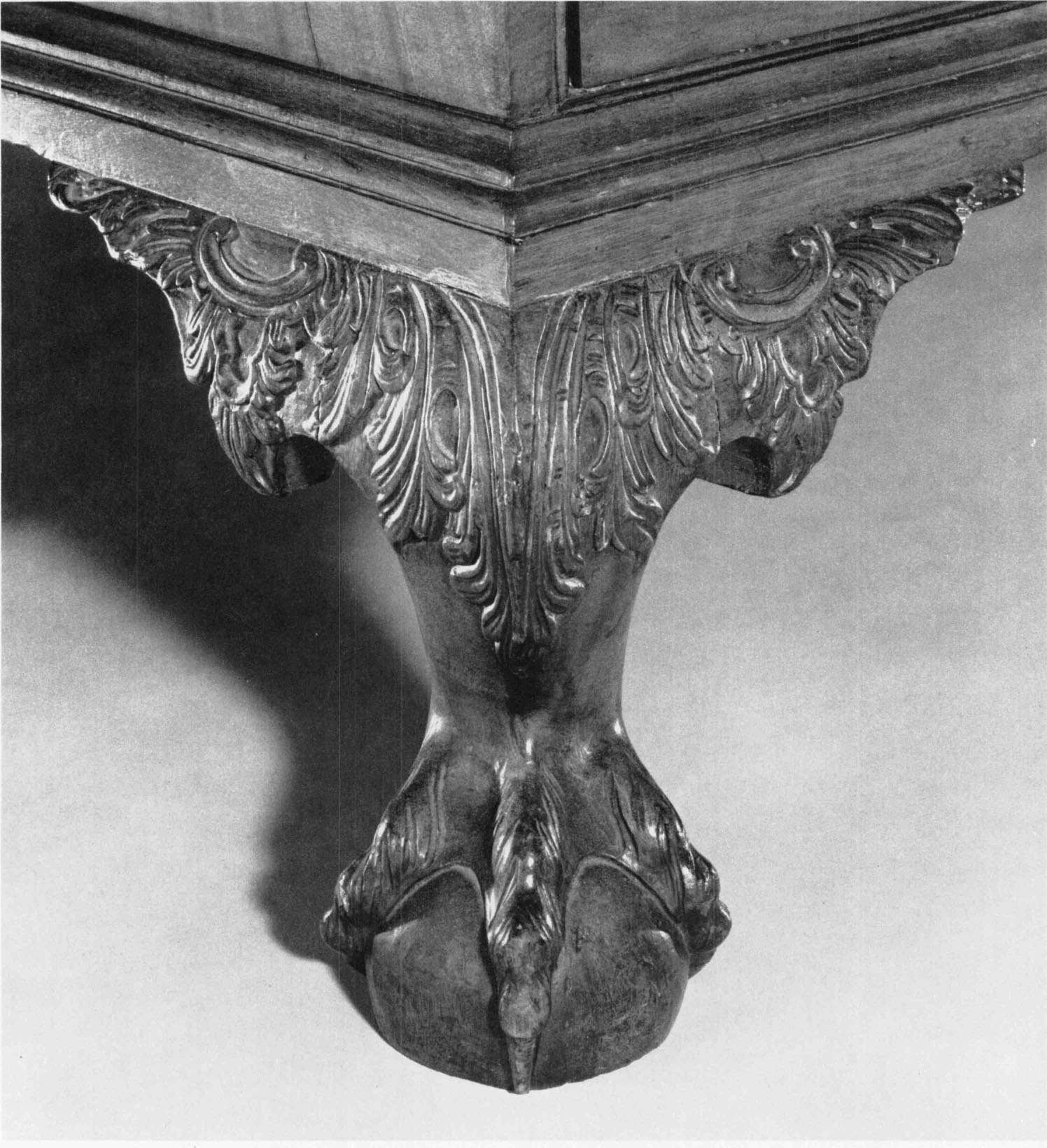
139. Detail of Carved Foot of Chest-on-Chest. Made by John Cogswell. (Museum of Fine Arts, Boston, William Francis Warden Fund, 1973.289.) See also figs. 125 and 143.
It is comparatively easy to sort, sift, and separate visual data, but no carved work can yet be associated with the name of a known carver. Therefore, this discussion of ornamental carving on Boston furniture emphasizes the carving styles. The names of some craftsmen likely to have executed the carved work will be suggested.
John Cogswell apparently employed more than one carver since carved work of very different styles is found on casepieces made by this cabinetmaker. The carver of the bracket feet on the signed Cogswell chest-on-chest (fig. 139) favored a general three-dimensional style of carving, with C-scrolls carved in high relief, dense leaves lapping one over the other, and shallow grooves used to articulate the surface of the leaves. Similarly carved feet are found on a chest of drawers at the Museum of Fine Arts, Boston (figs. 128 and 142), which, on the basis of the carving style and construction details, is attributed to Cogswell. A different carver undoubtedly executed the sophisticated decoration applied to the pediment (fig. 143) of the signed Cogswell chest-on-chest as the rich, highly three-dimensional style of the carving is quite different from that of the carving on the bracket feet.
Another type of three-dimensional carving is seen on a side chair in the Museum of Fine Arts, Boston (fig. 144), from the James Prince Mansion in Newburyport and probably made for Nathaniel Tracy (1751–1796), a prosperous merchant and previous owner of the house. The chair is part of a set including four other chairs and a sofa which was exhibited as American at the Girl Scout Loan Exhibition of 1929. (The sofa is in the collection of Colonial Williamsburg.) There is now doubt as to the origin of the group of furniture. The seat frames are beech and thin, open seat braces are used. If the beech can be identified by micro-analysis as American beech, this elaborately carved group of furniture from the Boston area will present a new area of study in Boston carving of the three-dimensional type.
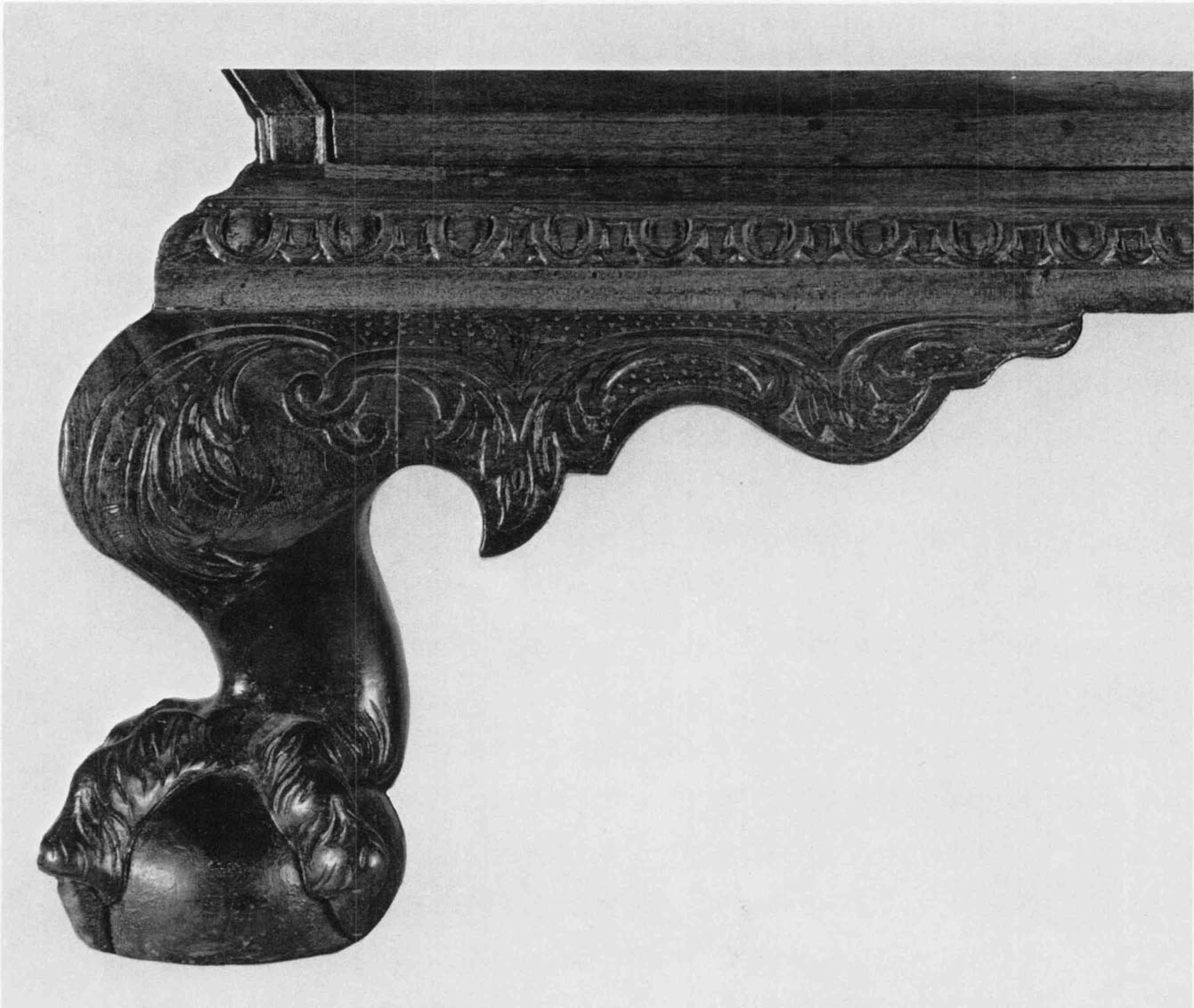
140. Detail of Carved Foot of Desk and Bookcase. Made by George Bright. (Museum of Fine Arts, Boston, Bequest of Miss Charlotte Hazen, 56.1194.) See also fig. 124.
The craftsman who carved the George Bright desk and bookcase had a distinctive style of his own characterized by an overall two-dimensionality (fig. 140). On the carved feet and brackets he used long narrow grooves to articulate the surface of sparse, hatchet-shaped leaves. A star-punched background partially fills the uncarved surface. The carving on the bracket is contained by a smooth band along the lower edge.
Two-dimensionality characterizes much of the carving on Massachusetts Chippendale furniture, but some ornamentation relates directly to the work on the Bright desk and bookcase. A bombé chest of drawers with serpentine front in the Museum of Fine Arts, Boston, has claw and ball feet and brackets with similarly fashioned leaves, a star-punched background, and a smooth band forming a border along the bracket’s lower edge.181 It is unlikely, however, that the two pieces of furniture were carved by the same hand for different punches were used on the two backgrounds and the smooth bordered edge extends much further along the bracket on the chest than on the desk and bookcase. The similarities suggest that the craftsman who executed the carving on the chest was familiar with, if not trained by, the craftsman responsible for the carving on the Bright desk and bookcase.
The third major style of furniture carving seen in Boston in the Chippendale period appears on a very interesting and sophisticated group of furniture notable for its unusual, asymmetrically designed carved decorations. The group consists of: matching settees in the Winterthur Museum (fig. 145) and the Metropolitan Museum of Art; a card table in a private collection; two armchairs and ten side chairs at the Yale University Art Gallery (fig. 141); a side chair at the Winterthur Museum (fig. 146); and an armchair in the collection of Israel Sack, Inc. (fig. 147). For the sake of convenience, Chart I lists various pieces of seating furniture belonging to this group, giving secondary woods, construction methods, and pertinent measurements.
The most distinctive feature of the pieces of furniture in this group, a feature that they all have in common, is the unusual carved ornamentation on the knees. The decorative motif is markedly asymmetrical. (Most carved designs on American Chippendale furniture are totally symmetrical in spite of the rococo penchant for asymmetry.) It consists of a large C-scroll with leafy appendages placed diagonally across the surface of the knee. Beneath the C-scroll hangs a wilted and drooping leaf.
| Location | Type | Construction; woods | Measurements |
|---|---|---|---|
|
1. Winterthur 51.80 |
Armchair knee with asymmetrical carving; hairy paw feet |
beech seat frame; thin beech open seat braces |
h. 37¼″, w. 25½″, d. 20½″ |
|
2. Israel Sack, Inc. |
Armchair knee with asymmetrical carving; claw and ball feet |
maple rear seat rail veneered with mahogany; triangular corner blocks (3½″ × 1½″) with thin chamfered edge, held in place by 2 round-headed nails ⅜″d. |
h. 37½″, w. 29″, d. 19″ W. top rail: 20⅜″ Splat: h. 19¾″ w. at rosettes 8½″, w. at base 49/10″ Seat: w. rear 17⅞″, w. front 22¾″, d. 17″ H. of leg: 14⅝″ |
|
3. Yale University 1967.28.1 |
Side chair knee with asymmetrical carving; claw and ball feet |
maple seat frame; white pine triangular corner blocks (3¼″ × 1½″) with thin chamfered edge, held in place by 4 round-headed nails ¼″d.; American black ash and maple open seat braces held in place with round-headed nails ⅜″d. |
h. 37⅝″, w. 22⅞″, d. 18¾″ W. top rail: 20½″ Splat: h. 19¾″, w. at rosettes 8½″, w. at base 49/10″ Seat: w. rear 17⅞″, w. front 22⅞″, d. 17¼″ H. of leg: 14⅝″ |
|
4. Yale University 1967.26 |
Armchair knee with asymmetrical carving; claw and ball feet |
maple seat frame; birch rear triangular corner blocks (3 ¼″ × 1½″) with thin chamfered edge, held in place by 2 round-headed nails ⅜″d.; maple open seat braces |
h. 37⅜″, w. 26½″, d. 199/16″ W. top rail: 21½″ Splat: h. 19¾″, w. at rosettes 9¼″, w. at base 58/10″ Seat: w. rear 18⅞″, w. front 25½″, d. 18¼″ H. of leg: 14⅝″ |
|
5. Winterthur 52.242 |
Side chair knee with asymmetrical carving; hairy paw feet |
oak rear seat rail veneered with mahogany; triangular corner blocks cherry (3½″ × 1½″) with thin chamfered edge, held in place by screws that have replaced original nails |
h. 37″, w. 21½″, d. 17¾″ W. top rail: 20⅜″ Splat: h. 19¼″, H. of leg: 14⅝″ |
|
6. Winterthur 59.1877 |
Settee knee with asymmetrical carving; claw and ball feet |
maple seat rail and rear legs, also top of scroll arms; cedar top rail, side rail, front and sides of arms; birch brace of top rail; triangular corner blocks (45/16″ × 2⅛″) with thin chamfered edge, held in place by 4 round-headed nails ⅜″d. |
h. 36″, l. 57″, d. 24″ H. of leg: 14⅝″ |
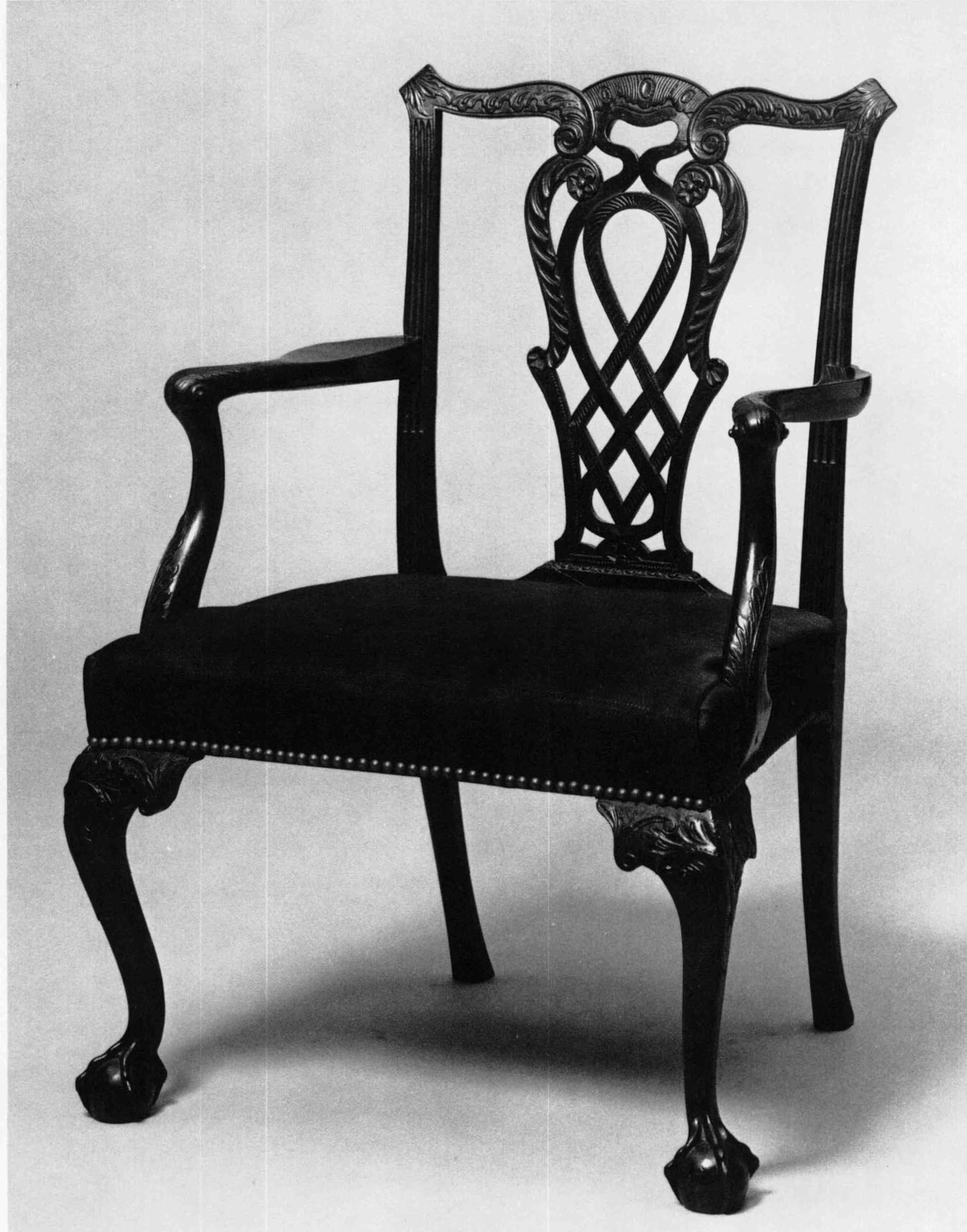
141. Armchair. Boston area, c. 1760–1780. Mahogany, maple, and birch; h. 37⅜ inches, w. 26½ inches, d. 199/16 inches. (Yale University Art Gallery, Mabel Brady Garvan Collection.)
An armchair at Winterthur (fig. 148 and no. 1, chart i) seemingly identical to the group of chairs at Yale University (fig. 141 and nos. 3 and 4, chart i)—with the same asymmetrical knee decoration and the same splat design—proves on closer inspection, however, to have been carved by a different hand than all of the other pieces of furniture in the group. A close look reveals many subtle differences.
The Winterthur armchair has stiles fluted in an a, b, a pattern with the center flute rising higher than those to the sides. Its carved leafage across the top rail descends to various levels on the rail. The flutes on the splat’s central figure-eight motif are closely spaced and subtly varied in direction to follow the curve of the figure-eight.
In contrast, the carving on the set of chairs at Yale (fig. 141 and nos. 3, 4, chart i) and that on an armchair owned by Israel Sack (fig. 147 and no. 2, chart i) show a less artistic hand at work. The flutes in the stiles all reach the same height. The carved leafage across the top rail is equidistant from the lower edge of the rail. There are far fewer flutes on the figure-eight motif on the splat and these are rather carelessly arranged.
One may conclude that the chairs at Yale and the chair owned by Israel Sack, Inc., were copied from the chair owned by Winterthur, but copied by a craftsman who was not so particular in carrying out the details of execution. There has long been speculation about whether the Winterthur chair is American. Acting on the authority of an antiques dealer in Massachusetts who told him that the chair was found in a Massachusetts house, Joseph Downs considered the chair as American despite its beech seat frame and traditionally English seat braces.182
It seems quite likely that the armchair at Winterthur is English183 and that it or a member of its set (the Museum of Fine Arts, Boston, owns a seemingly identical side chair) was used as the model for the rest of the furniture in this group. Particularly intriguing in this context are the thick, wide, open seat braces found on the twelve chairs at Yale. It seems as though the Boston chairmaker attempted to copy not only the design and carving of the English chair, but also its method of construction. The open seat braces on the Boston-made versions are much heavier and cruder than on the imported model, and the Boston chairmaker refused to abandon his own traditional method of supporting the chair seats with triangular corner blocks, so that the seats are supported by both open braces and corner blocks.
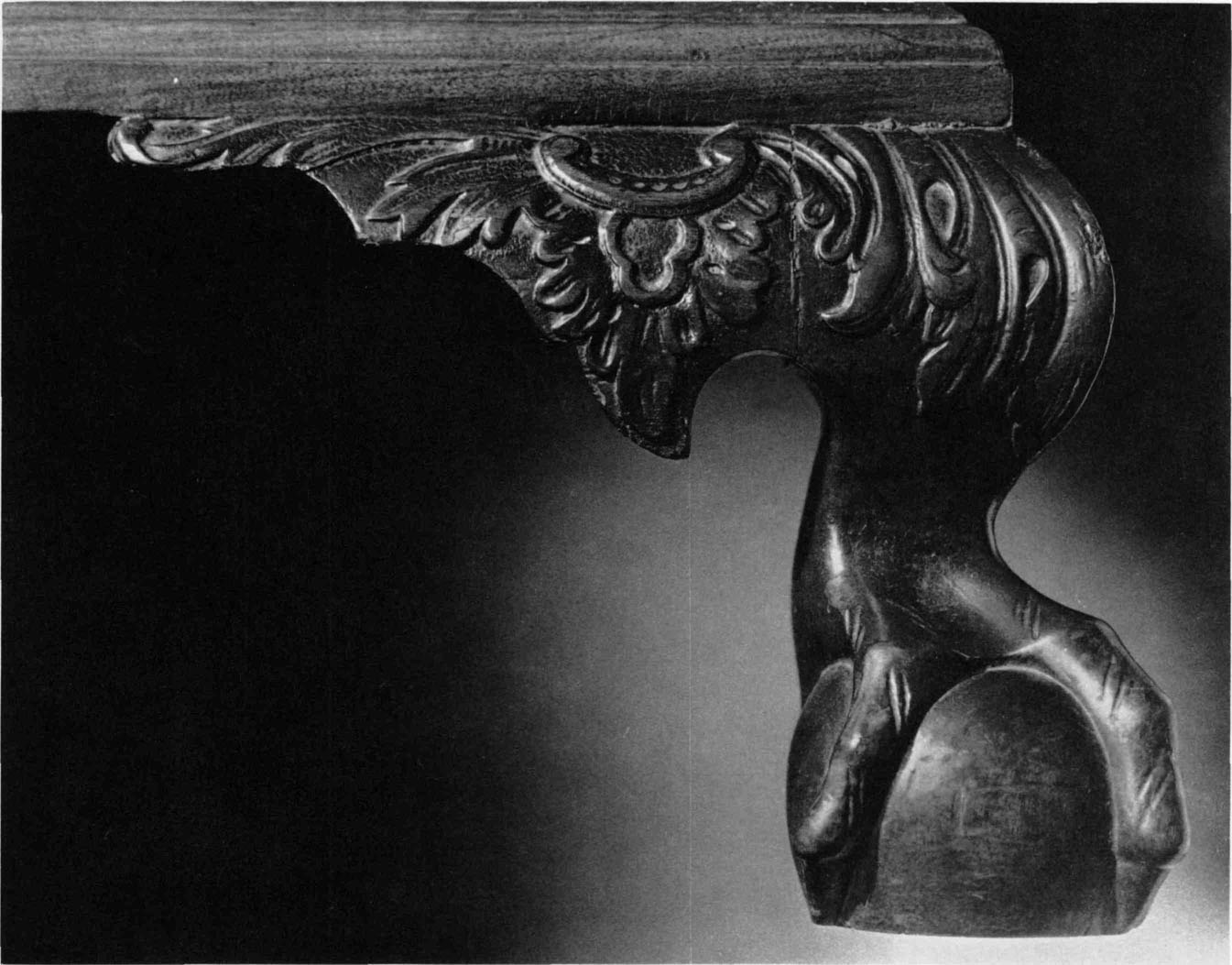
142. Detail of Carved Foot of Chest of Drawers. Attributed to John Cogswell. (Museum of Fine Arts, Boston, Bequest of Maria Theresa Burnham Hopkins, 37.34.) See also fig. 128.
Consistent construction methods indicate that chairmaker and carver (and they may have been the same person) worked on all of the members of this particular group of furniture. In each chair and in the settees the maker used triangular corner blocks with thinly chamfered edges, approximately 3½ inches wide, held in place with either four or two large, round-headed nails. The Yale chairs (fig. 141 and nos. 3, 4, chart i) are upholstered over the frame; the Sack chair (fig. 147 and no. 2, chart i) and a side chair at Winterthur (fig. 146 and no. 5, chart i) have slip seats with rear seat rails veneered with mahogany. Although the splat of the Winterthur side chair is not the same design as that of the other chairs in this group, its cresting rail was made with the same template used for the top rails of the other chairs (they all measure 20½ inches in width). All of the legs belonging to the group of chairs and settees measure 14⅝ inches in height, indicating that the craftsman worked on a piece basis, turning out carved leg after carved leg (thirty-two legs in all). Only the center legs of the settees differ in style.
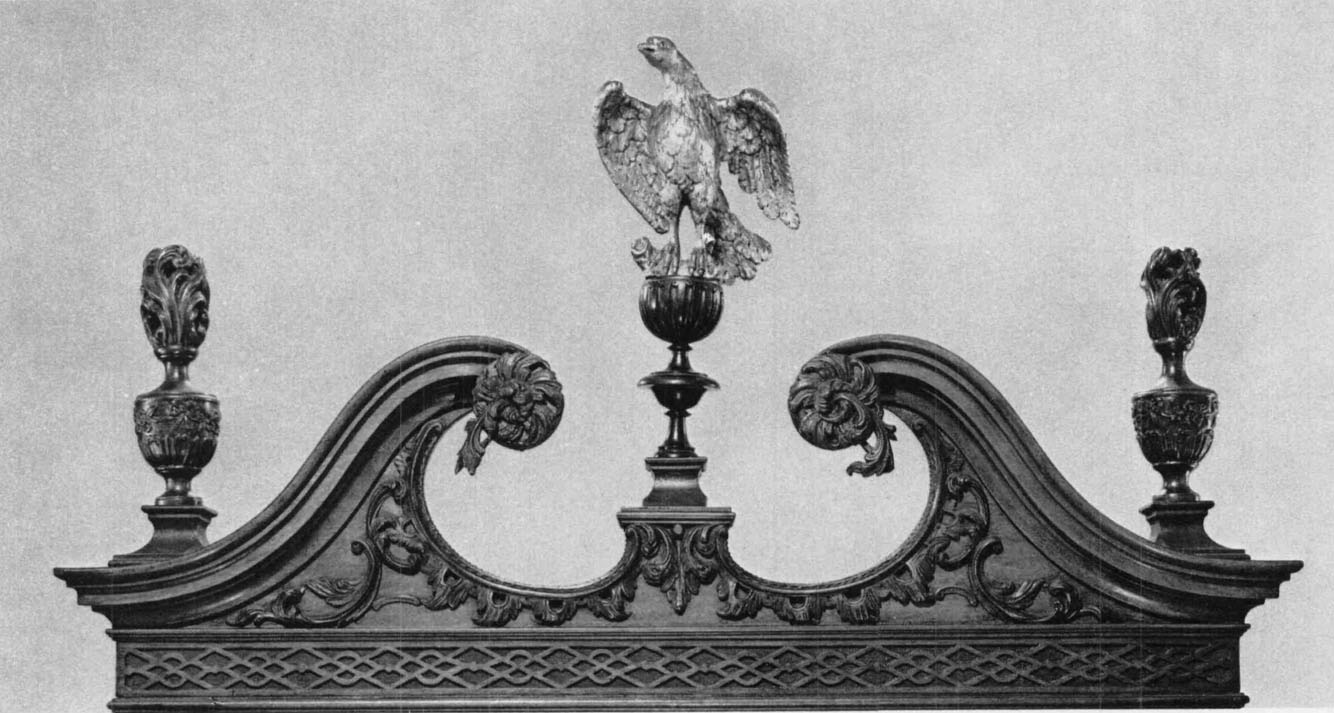
143. Detail of Pediment of Chest-on-Chest. Made by John Cogswell. (Museum of Fine Arts, Boston, William Francis Warden Fund, 1973.289.) See also figs. 125 and 139.
More modest types of chairs produced in Boston in the 1770s and 1780s also show interesting carved work by three or more different hands. A variety of chairs arranged by splat type are listed in Chart II giving details of construction, secondary woods, and measurements.
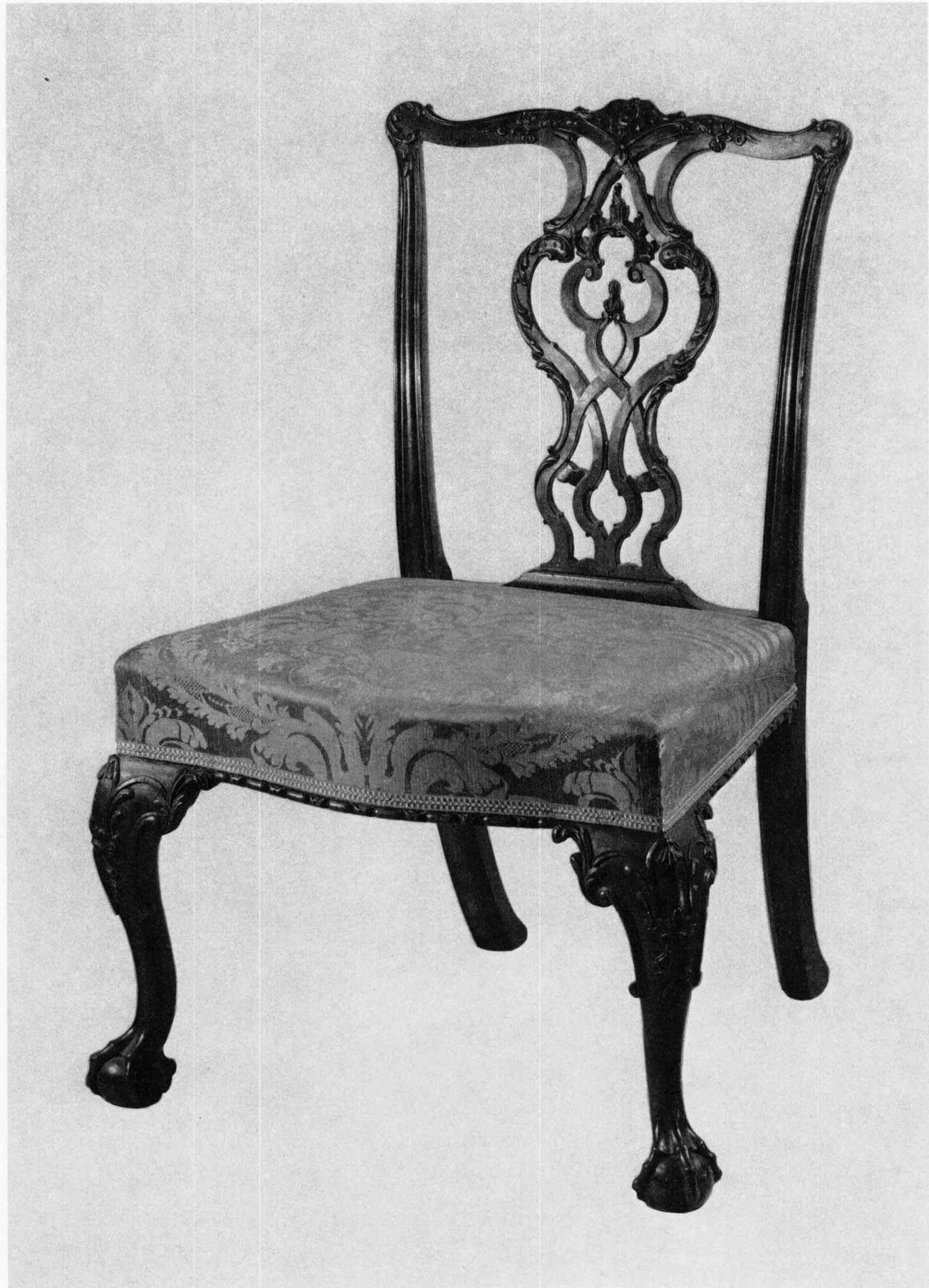
144. Side Chair. England or Boston area, c. 1760–1780. Mahogany and beech; h. 37¼ inches, w. 22½ inches, d. 19 inches. (Museum of Fine Arts, Boston, Gift of Mrs. Guy Currier, 35.1977.) According to family tradition, this chair was owned by Nathaniel Tracy (1751–1796) of Newburyport, Massachusetts.
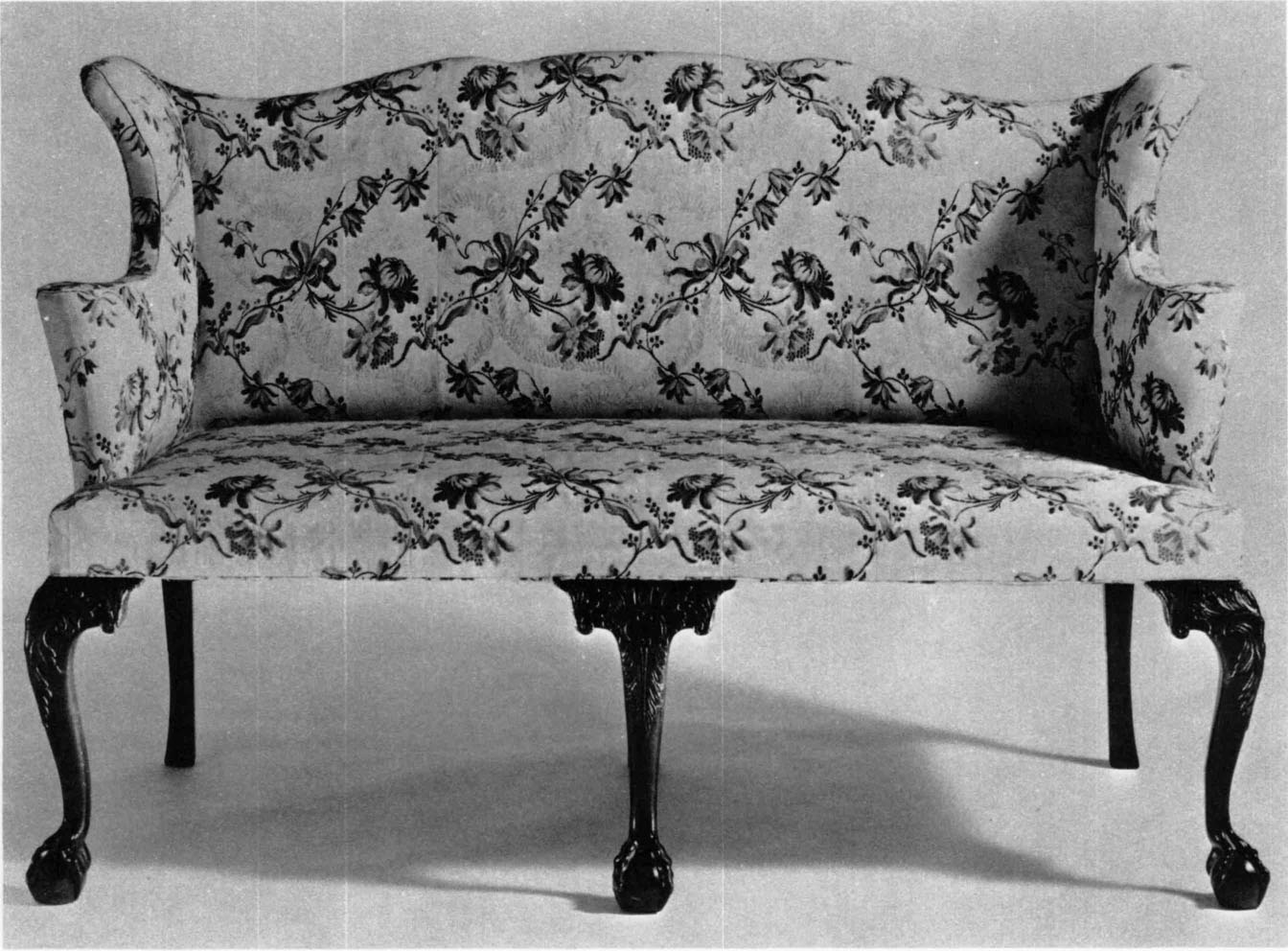
145. Settee. Boston area, c. 1760–1780. Mahogany, maple, cedar, and birch; h. 36 inches, w. 57 inches, d. 24 inches. (The Henry Francis du Pont Winterthur Museum.)
A Boston-made chair popular among those who could afford mahogany furniture was one with a splat of intertwined scrolls, splat a. Examples are located in the Winterthur Museum (no. 1, chart ii), the Museum of Fine Arts, Boston (fig. 149 and no. 2, chart ii), and the Metropolitan Museum of Art (no. 4, chart ii). Chairs of this type, found frequently in New England, appear not only with ornamental carving, but also in a plain, undecorated form.
Chairs numbers 1 and 2 (fig. 149) on Chart II with this splat design appear identical to chairs numbers 3 (fig. 150) and 4 with the same splat, but subtle differences in the size of the carved motifs indicate that the chairs were carved by different hands. Differences in construction further indicate that chairs numbers 3 and 4 were not produced in the same shop as numbers 1 and 2, emphasizing the popularity of the chair design.
Numbers 5 (fig. 151) and 6 are two chairs from a large set with unusual splat designs of attenuated C-scrolls, a central Gothic arch, and a small solid trefoil near the base, splat b. They were probably made by the same chairmaker who fashioned chairs numbers 3 (fig. 150) and 4, or, at least, carved by the same hand.
Chairs numbers 8 and 9 with splat c (fig. 152) are copied from plate 9 in Robert Manwaring’s The Cabinet and Chair-Maker’s Real Friend and Companion (London, 1765). A very differently designed chair with a two-tiered Gothic splat (fig. 153 and no. 10, chart ii), splat d, shows a similar two-dimensional style of carving and similar construction, making tenable an attribution to the same shop and carver. The carving on the chair with the two-tiered splat relates in its two-dimensional character to that on the Bright desk and bookcase (fig. 140).
Although as yet no carver can be identified with a specific piece of furniture, there is an accumulating body of documentary material relating to a number of craftsmen known to have been working in Boston between 1755 and 1785.
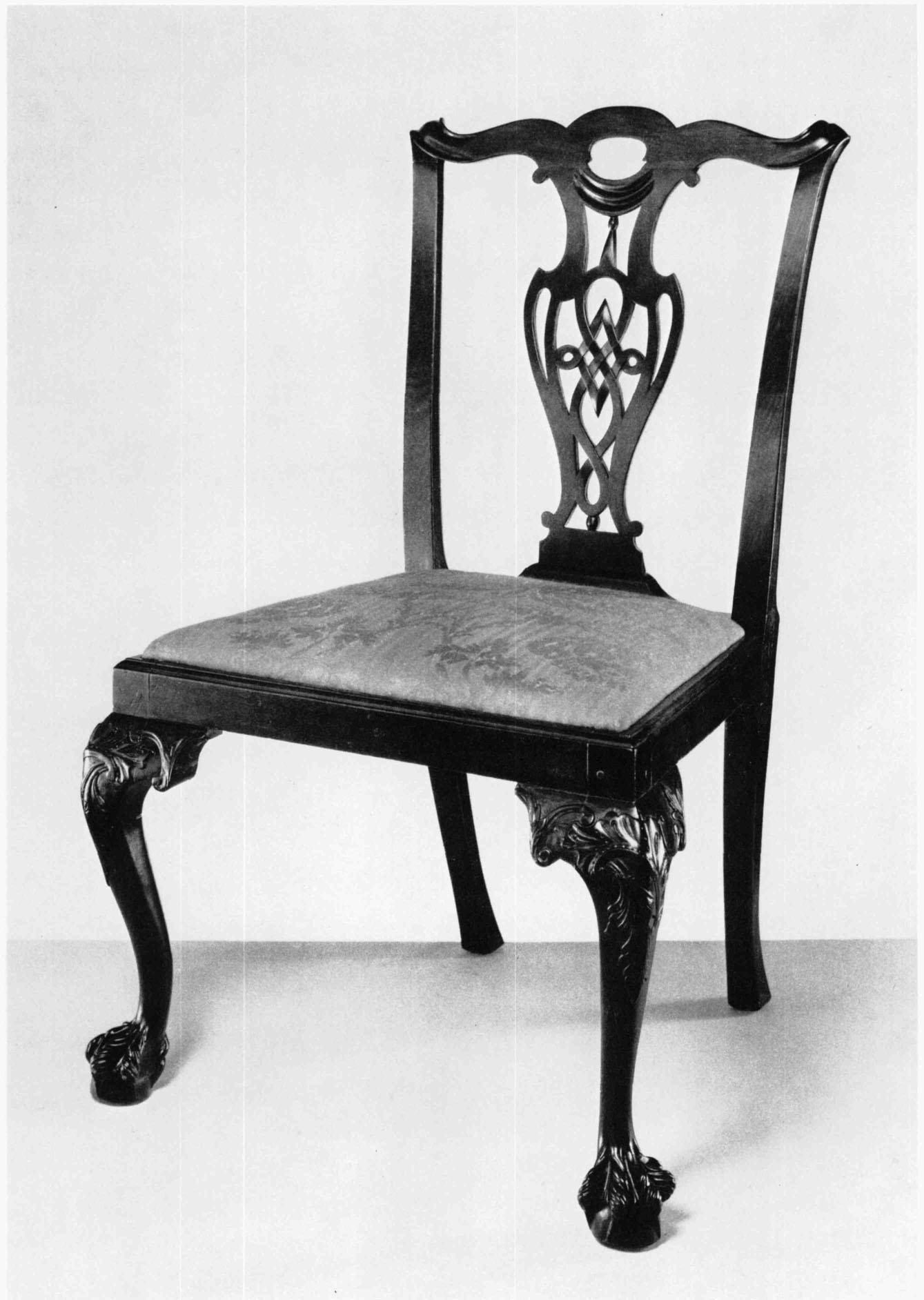
146. Side Chair. Boston area, c. 1760–1780. Mahogany, oak, and cherry; h. 37 inches, w. 21½ inches, d. 17¾ inches. (The Henry Francis du Pont Winterthur Museum.)
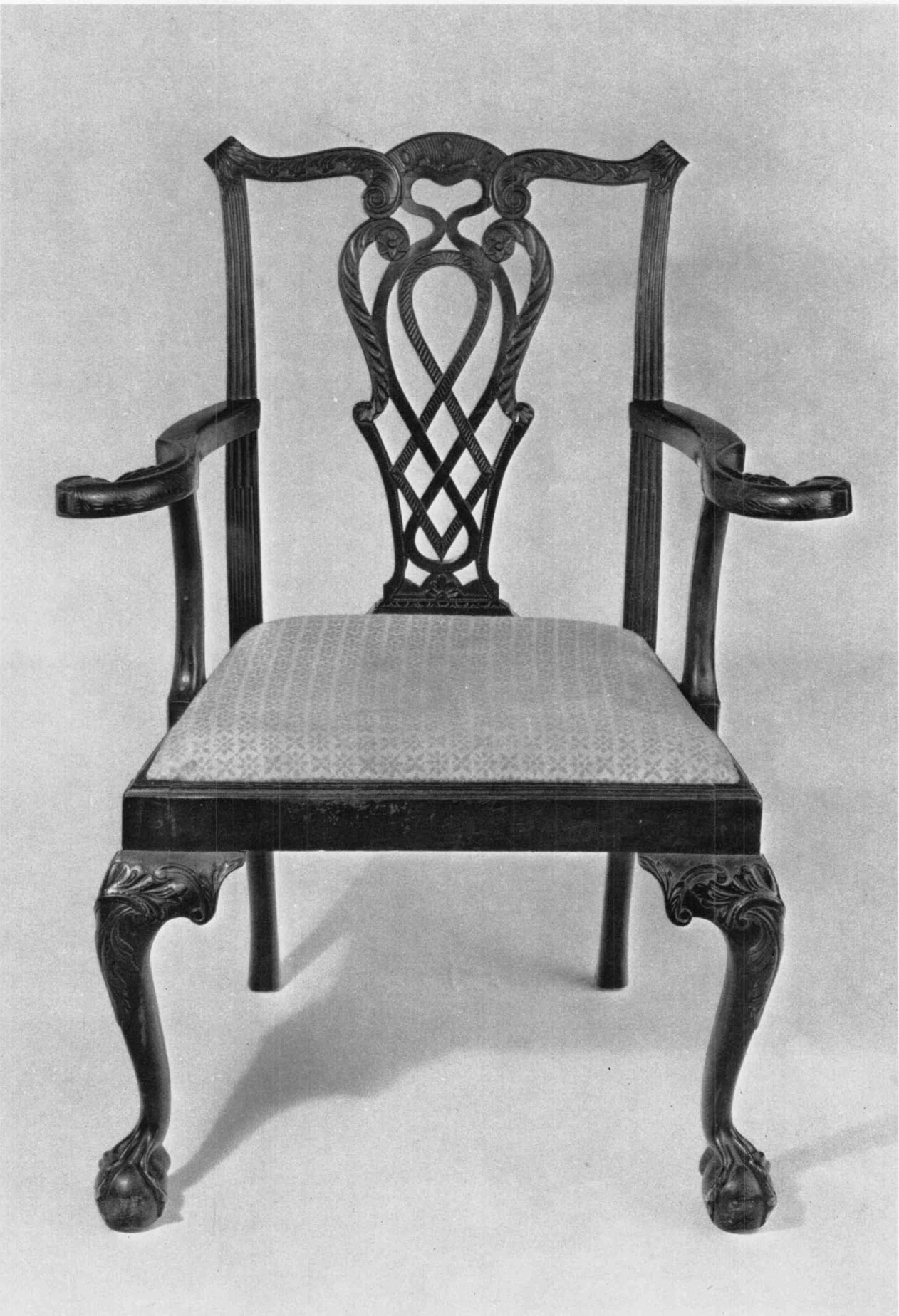
147. Armchair. Boston area, c. 1760–1780. Mahogany and maple; h. 37½ inches, w. 29 inches, d. 19 inches. (Israel Sack, Inc., New York City.) According to family tradition, this chair was owned by Elias Hasket Derby (1739–1799) of Salem.
One of the most important identifiable carvers of pre-Revolutionary Boston was John Welch. Born in 1711, Welch is famed for carving the “Sacred Codfish” for the Hall of Representatives in the Boston State House in 1736.184 In 1733 he purchased a lot of land forty by eighty feet in Green Lane, or in Green Street,185 presumably in anticipation of his marriage to the granddaughter of the prosperous carver George Robinson. The association with the Robinson family was an important one for Welch. He may have served an apprenticeship under Robinson. The unfortunate death of Welch’s young wife in 1736 left Welch with a substantial portion of the Robinson estate.186 In 1738 and 1743 Welch increased his holdings in the Green Street area.187 He made his home on Green Lane, but from 1733 until 1758 he kept a shop on the town dock, a good location for a man who was probably primarily a ship carver.
In 1758 Isaac Dupee, a ship carver, petitioned to have the use of the “Town’s shop that John Welch occupied.”188 In the same year Welch advertised the sale of many household possessions because he proposed “to go to England in a short time.” He did travel to England, presumably on business, but returned to Boston about 1760.189
The 1789 inventory of Welch’s estate indicates that he was involved in the sale of imported looking glasses. A list of shop goods includes a gilt framed glass, a mahogany framed glass, and four looking glass frames as well as carving tools and “5 ps Carved Work.”190 The inventory of his personal property lists “A Marble slab and frame” and “2 Busts,”191 an intriguing reference when one recalls the popularity of carved busts as ornaments for casepieces in Boston in the 1770s and 1780s.
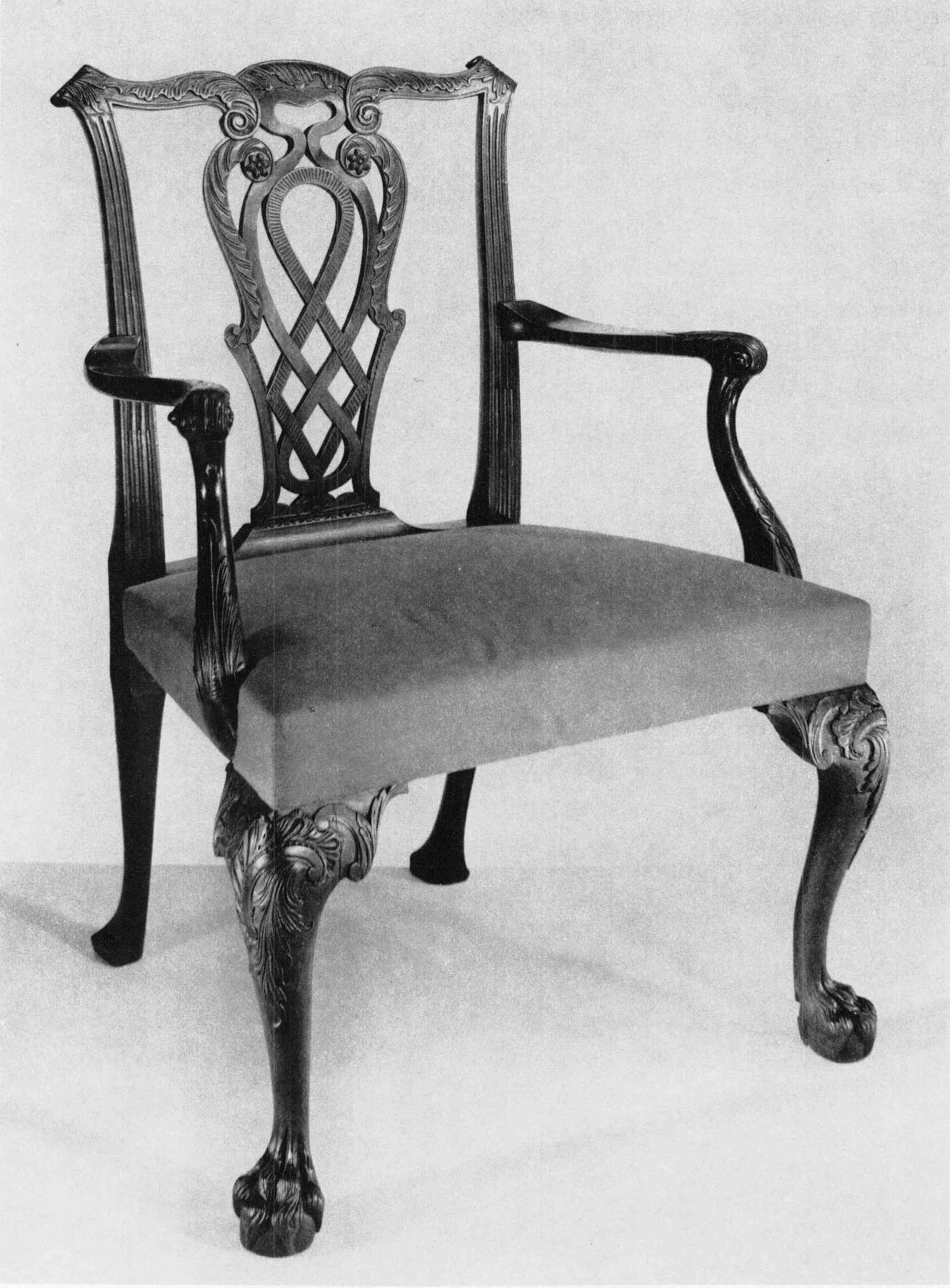
148. Armchair. England, c. 1760–1780. Mahogany and beech; h. 37¼ inches, w. 25½ inches, d. 20½ inches. (The Henry Francis du Pont Winterthur Museum.)
Welch was a very prosperous carver in pre-Revolutionary Boston. The list of his household furniture before the 1758 trip to England included: “Large and Small Sconces, Looking Glasses, Chimney and Dressing Glasses, a very handsome japanned Chest of Drawers and Bureau, a Marble topped table supported by Carved Eagles.”192 Numerous real estate transactions established Welch as a shrewd businessman. In May, 1774, for example, John Welch bought a lot adjoining his own in Green Lane from John Singleton Copley for £153 and resold it a few weeks later for £253.193 He also had property in the Bowdoin Square-Sudbury Street area and in 1780 he paid the large tax of £50, more than double the sum paid by any other Boston carver.194
Most of the other men designated as carvers in public records seem, like Welch, to have been primarily ship carvers. Joshua Bowles and Thomas Luckis had been keeping shop together along the wharf when their inventory was destroyed by the great fire of 1760. They were also engaged in other aspects of the shipping trade for in addition to the “3 Carved heads and carving tools,” they lost two boat masts, fifteen cod and mackerel lines, and three barrels of flour.195 A bill from Bowles and Luckis to John Hancock further identifies these carvers as ship carvers. Mr. Hancock was charged £28 for a woman’s head “7 foot long” and £13 more for brackets, a trail board, and two scrolls.196 By 1780, Joshua Bowles and Thomas Luckis were working separately. At that time Bowles appears to have been slightly more successful, but by Luckis’ death in 1808 he had improved his financial situation and had a house and land on Scotts Court worth $3000.197
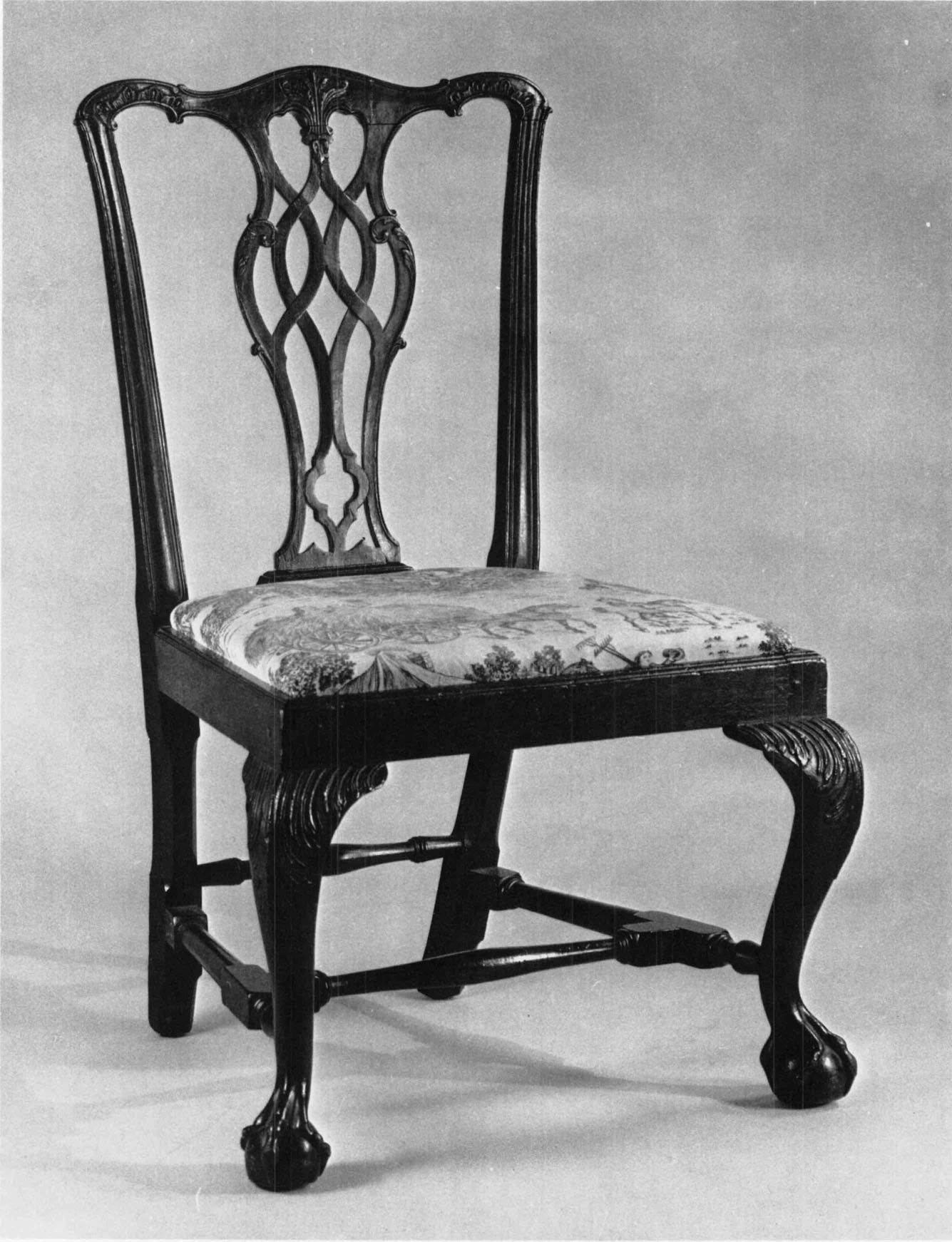
149. Side Chair. Boston, c. 1760–1780. Mahogany, maple, and white pine; h. 37 inches, w. 21⅜ inches, d. 17⅝ inches. (Museum of Fine Arts, Boston, Gift of Mrs. F. Carrington Weems, 60.1176.) This chair descended in the Lane family of Boston. The splat of this chair is an example of splat A.
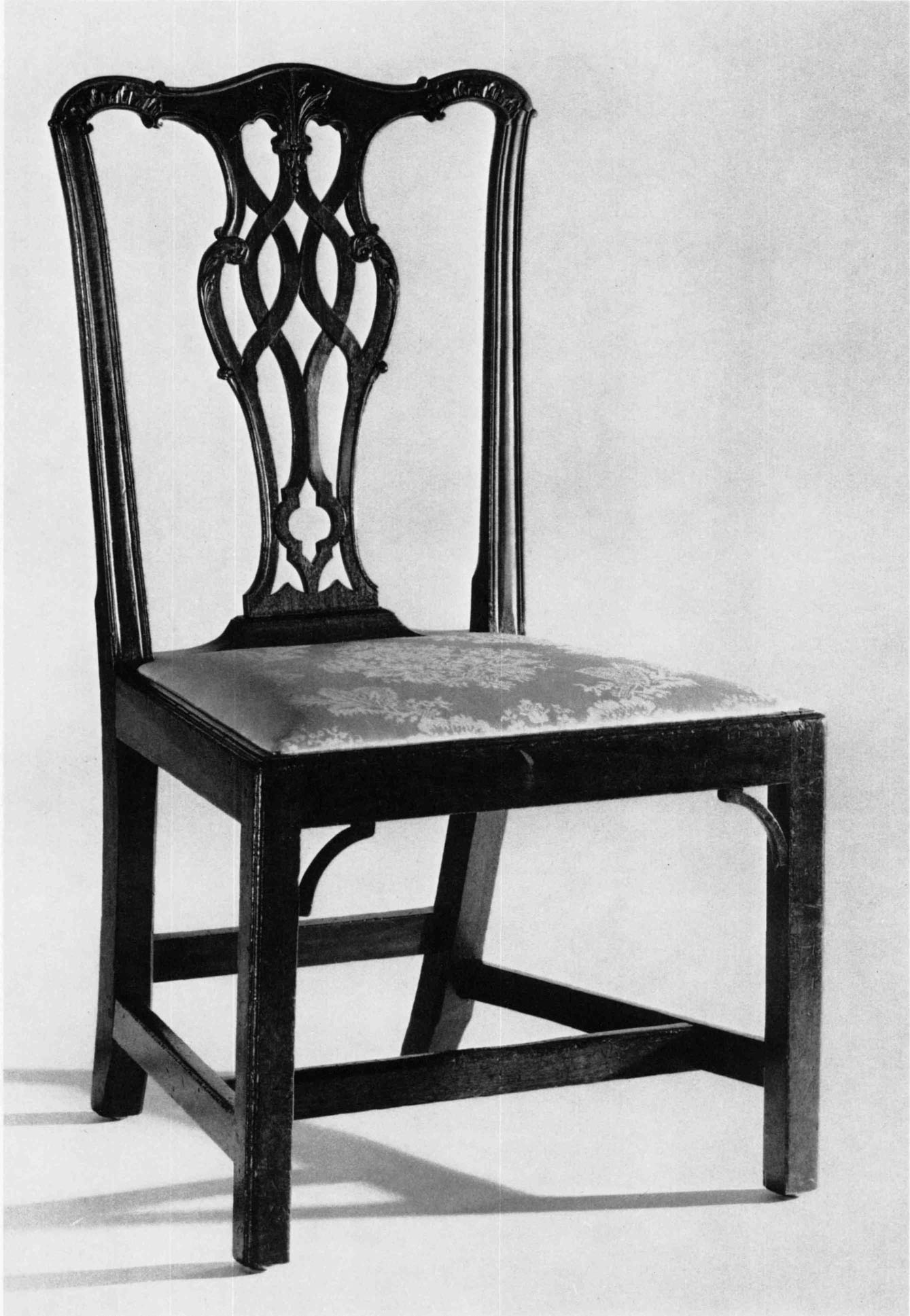
150. Side Chair. Boston area, c. 1760–1780. Mahogany; h. 36¾ inches, w. 21¼ inches, d. 18 inches. (The Henry Francis du Pont Winterthur Museum.) Splat A.
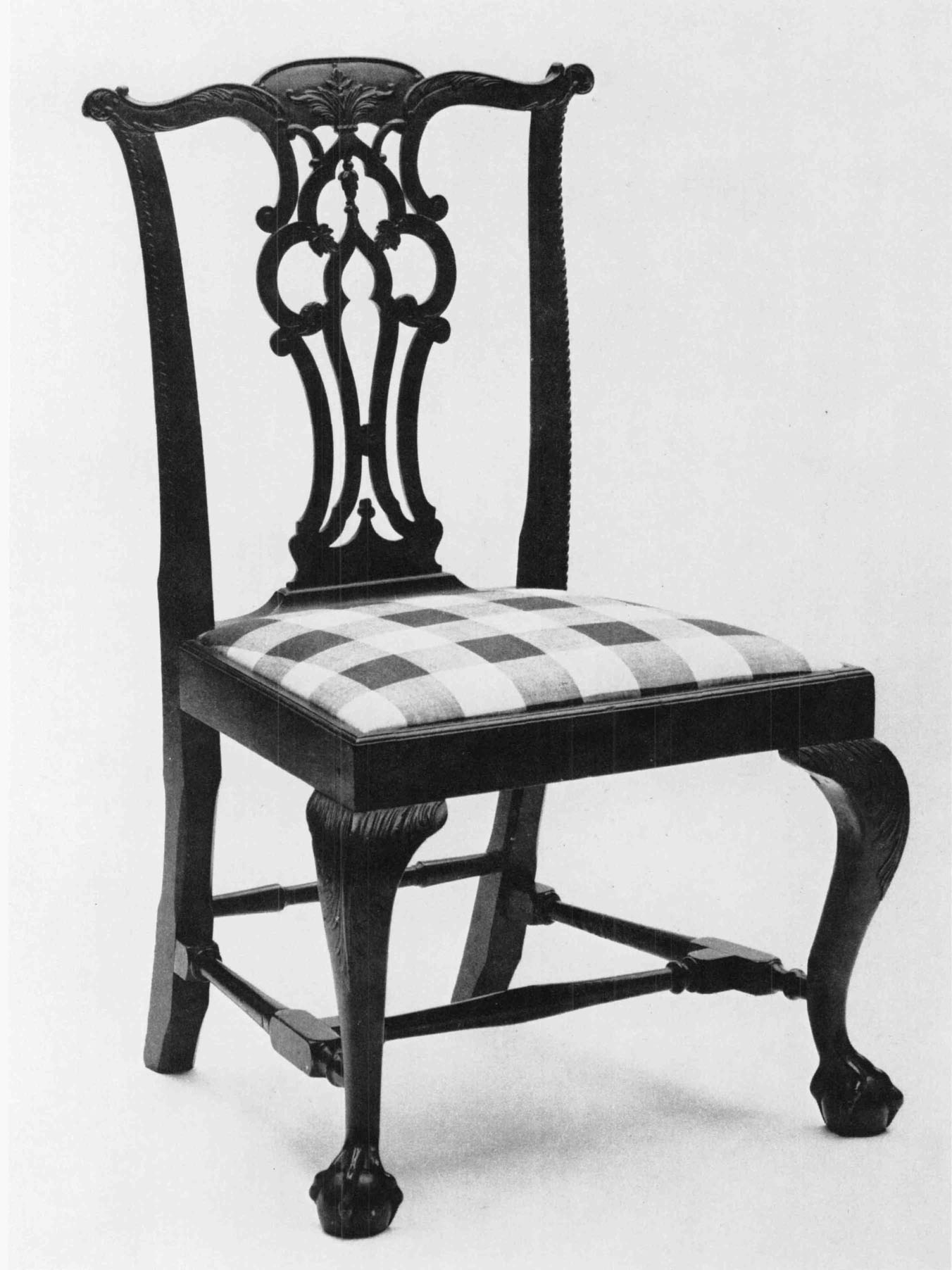
151. Side Chair. Boston, c. 1760–1780. Mahogany; h. 38 inches, w. 23½ inches, d. 19 inches. (The Henry Francis du Pont Winterthur Museum.) This chair descended in the De Wolf family of Boston. The splat of this chair is an example of splat B.
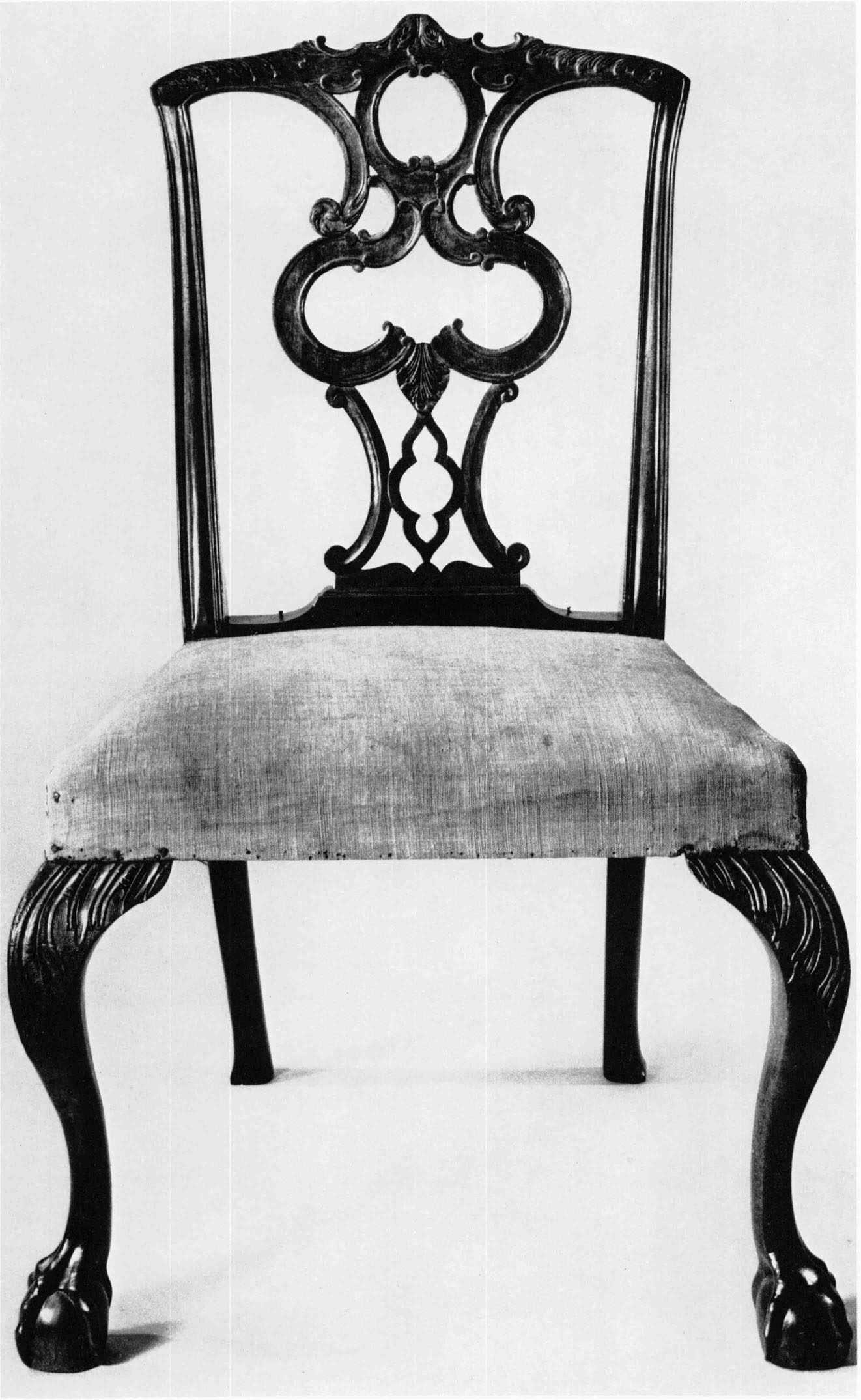
152. Side Chair. Boston or Salem, c. 1760–1780. Mahogany, maple, and white pine; h. 38¼ inches, w. 23⅝ inches, d. 17¾ inches. (Massachusetts Historical Society: photo, Richard Cheek.) Splat C.
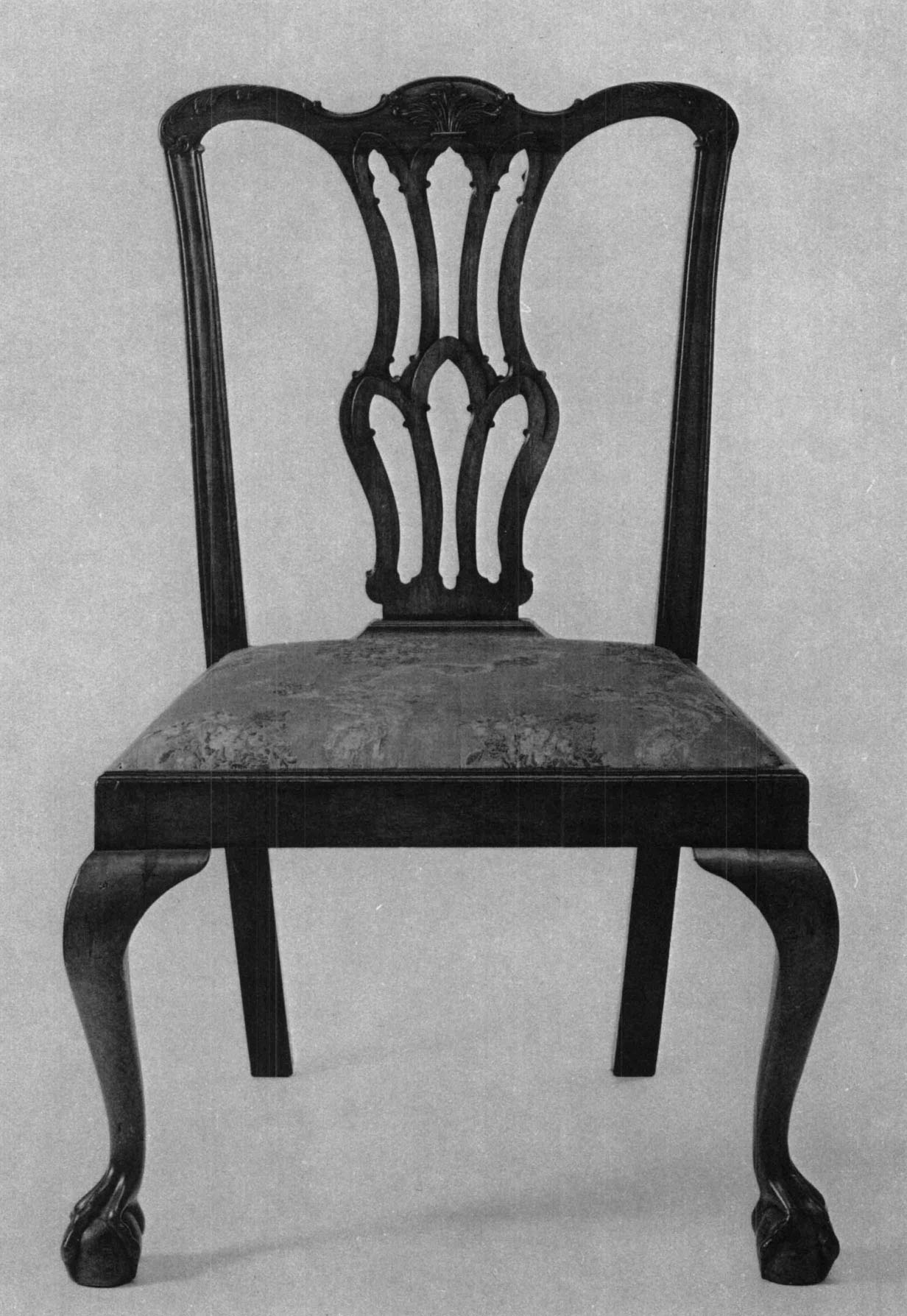
153. Side Chair. Boston, c. 1760–1780. Mahogany, maple, and white pine; h. 38 inches, w. 2215/16 inches, d. 19 inches. (Museum of Fine Arts, Boston, Gift of Mary W. Bartol, John W. Bartol, and Abigail W. Clark, Res. 28.78.) According to family tradition, this chair was owned by James Swan (1754–1830) of Boston and Dorchester. The splat of this chair is an example of splat D.
Another known carver is Simeon Skillin, Sr., who was in business by 1741 in Salutation Alley.198 Simeon Skillin’s activities as a ship carver are well documented but no evidence has been found to show that he carved for cabinetmakers.
Joshua Bowles, Thomas Luckis, and Simeon Skillin may have sometimes carved furniture for the great Boston cabinetmakers, but probably they did not permanently associate themselves with one particular cabinetmaker.
One prominent Boston cabinetmaker who may have employed carvers is Alexander Edwards. Although little is known about his life, his economic success in the cabinetmaking trade associates him with a high-style, highly decorated type of furniture.
Alexander Edwards’ father, Benjamin Edwards, a mariner, arrived in Boston in 1716 and three years later bought a large piece of property in Back Street.199 During his thirty-five years in Boston Benjamin Edwards became a successful merchant, owning at the time of his death in 1751 a “Mansion House” with warehouse and wharf worth £800, four other houses in Back Street, Ship Street, and White Bread Alley, and two Negro slaves.200
When his father died, Alexander was eighteen years old and still considered a minor. The cabinetmaker Thomas Sherburne, a neighbor, was made his guardian and probably Edwards was apprenticed to Sherburne in the cabinetmaking trade.201 Upon his maturity Alexander Edwards inherited his father’s Back Street property and set up shop there as a “Gentleman-Cabinetmaker.” He was a patriot and in March, 1777, was appointed to a committee of public safety representing Ward 4.202 In 1780 he was taxed the considerable sum of £120, the same amount as George Bright.203
As with the other Boston cabinetmakers, no carver’s name can be linked to Alexander Edwards. The difficulty of associating known carvers with existing carved furniture is compounded by the inability to readily discriminate in documentary sources among furniture, ship, or sign carvers.
This analytical study has attempted to isolate the different styles of the craftsmen who carved Boston furniture during the Chippendale period. Eventually, further study may link these styles with identifiable craftsmen and clarify the relationship between carvers and cabinetmakers.
